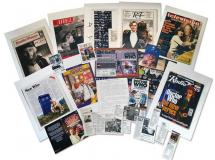
Changing the Face of Doctor Who
Designed by Colin Brockhurst
Additional illustrations by Steve Andrew
Published August 2015
Colin has now returned with a second set, Changing the Face of Doctor Who, which explores an alternative past where a different succession of actors assumed the role of the Doctor. Again, this is an exercise in counterfactual history which draws on recognisable events, settings and products but shifts them slightly sideways so the audience is engaged with an alternate past just that little more out of reach than the one we know. Geoffrey Bayldon stares out of the Radio Times launch cover Doctor Who never had in 1963. We’d not have had discussions over what kind of hat the second Doctor wore in early photographs had he been wearing Brian Blessed’s bowler. Ron Moody appears on the cover of a Radio Times from the first week of January 1970 being menaced by a Yeti, recalling the photocall which revealed Jon Pertwee’s third Doctor; but opening the brown envelope printed ‘Radio Times listings’ discloses that in Colin’s projected universe the third Doctor’s era began with Mervyn Haisman and Henry Lincoln’s Yeti tale The Laird of McCrimmon. How Ron Moody’s Doctor is exiled to twentieth-century Earth to take on Peter Cushing’s Master the following year in The Spray of Death must remain a subject for speculation. The Radio Times entries, inspired by unproduced tales which were abandoned in early stages of their development by the production office, are especially eerie because their phraseology and layout accurately recaptures the Radio Times of their pretended day. Colin is a master at sourcing and recreating typography from the days of hot metal composition and photogravure as he is at recapturing the house style of more recent periods, as shown by a glance at his material commemorating Rik Mayall’s eighth Doctor. Mayall’s screen life seems to have endured beyond one TV Movie, unlike his counterpart in our universe; I wonder if there is a range of Big Finish audios in Brockhurst-Earth’s mediasphere.
Frustratingly perhaps, this set only covers the first eight Doctors. There is no Radio Times cover featuring Hugh Grant and whichever recent graduate from Casualty or EastEnders was supposedly being considered to play Rose Tyler, no James Nesbitt and Robson Green staring out from opposite sides of a DVD box design, no Paterson Joseph and Aisling Loftus on the cover of Doctor Who Adventures… This decision might be regretted, but one (unhappy) consequence of the decision to end with the eighth Doctor (but not necessarily in 1996) is that most of the actors Colin has chosen as his alternative Doctors are dead, one very recently. Both this and the set's otherwise very limited engagement with post-2005 Doctor Who (but it is recognised, subtly) means that the set doesn’t risk confusing ongoing careers with what could be misinterpreted as marketing materials.
The nature of this kind of work means that Colin has to manage faces which sometimes do not want to be changed and where the source material to effect the transformation has been difficult to obtain, but ultimately the signatures of his alternative Doctors always overwrite those of the ones we know. His collaborator on some items is Steve Andrew, well-known in many fan circles for his Target book pastiches, who provides the cover illustration for the novelisation of Doctor Who and the Robots and for the badge showing Ron Moody’s Doctor in the style of the 1971 Kellogg’s Sugar Smacks series. Again, one suddenly feels the weight of cereal eaten to acquire it, long ago but elsewhen.
The set is definitely of interest to those who like testing the elasticity of Doctor Who’s past as well as its present and future and who imagine how the story of the Doctor and his companions (there are some alternative casting ideas there too) could have been depicted had different choices been made. Excite the interest and comment of all your friends, as Target Books once had it of their badge, but with Richard O’Brien’s Doctor’s first Doctor Who Magazine cover on your wall. In the meantime, I’m off to watch Ken Campbell’s Doctor in Storm Over Avallion – I’m sure I left the disc somewhere…

 Circle us on Google+
Circle us on Google+